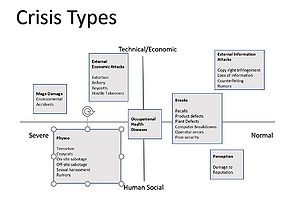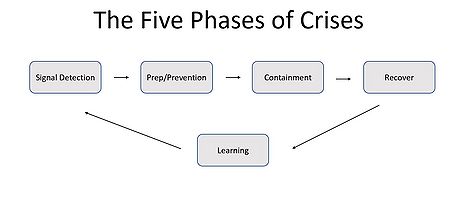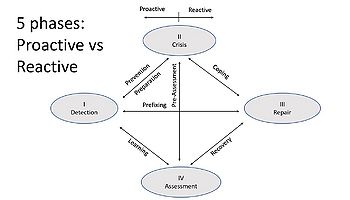Crisis Management in Construction Projects
Written by William Durant Mangum
Abstract
A project is a temporary endeavor undertaken to create a unique product, service, or result [1]. Many construction projects are often subject to crises during their lifetime and must either be overcome by managers to achieve the perceived benefits, or the project will fail. A crisis is seen as “a situation faced by an individual, group or organization which they are unable to cope with by the use of normal routine procedures and in which stress is created by sudden change.”[2]. While having potential disastrous affects, also offer an opportunity to align the team implementing the project, and also opportunity for improvement of potential benefits [3]. In the context of construction projects, crisis is usually something that disrupts the construction from continuing or causes the project to be extended. It should be noted that the purpose of crisis management is not only to prevent all crises, but to minimize the negative effects, have a quick and high-quality response, and to best prepare for all foreseeable crises. The main goal of this article is to cover the various tools project managers have to prevent crises in in construction projects, and the available tools to mitigate the negative effects of the crisis. Crisis Management in construction projects offer unique challenges because of the incredible uncertainty and immense initial capital investment at the beginning of construction in contrast to other types of projects.
Contents |
The Importance of Crisis Management in Construction
It is important to note the traditional system of procurement and tendering in construction projects is what leads to the importance of counteracting against crises. Through the process of traditionally procured projects, construction has two distinct phases of design and production. An architecture firm is usually hired by a client to oversee both, and one of the most important part is the tendering phase. In the tendering phase, a main contractor is selected to complete the construction usually normally based on lowest cost. The client then enters a direct contractual arrangement with the contractor and the bill of quantities becomes a binding document to which the contractor is paid. Then the constructor must complete the project, often using sub-contractors, with considerably penalties if finished late. Time and cost over-runs are common in modern construction. [2] There are three main causes of this extra risk. The first being the increasing complexity of client needs and technological advances have led to very complex buildings requiring specialization and fragmentation, which has led to a need for much greater managerial ability. Second, the traditional procurement process is purely sequential. However, clients increasing the urgency has caused the design and construction phases to overlap. The final reason being the abuse of competitive tendering has led to restrictively-low margins, which lead to lack of trust and confrontational relationships. With the uncertainty of construction leads to a hostile environment for project managers, which is why learning how to deal with crisis is so important. It has also led to improved predictive and preventative techniques. [2]
Principles of Crisis Management
As stated previously, a crisis is “a situation faced by an individual, group or organization which they are unable to cope with by the use of normal routine procedures and in which stress is created by sudden change.”[2]. Crises are also characterized by a high probability of occurrence. [3]
Crisis types
In general, there 6 major crisis types. Those being:
- External Economic Attacks- Extortion, bribery, boycotts, hostile takeovers
- External Information Attacks- copyright infringement, loss of information, counterfeiting, Rumors
- Breaks- Recalls, Product Defects, Plant Defects, Computer Breakdowns, Poor Operator errors, Poor Security
- Mega Damage- Environmental Accidents
- Occupational health Diseases
- Perceptual- Damage to reputation
- Psycho- Terrorism, Copycats, on-site Sabotage/tampering, off-site sabatoge/tampering/sexual harassment, rumors.

Change in Construction Crisis
Three managerial ironies emerge during a construction crisis. At a time when effective communication is important it is less likely; at a time when mutual sensitivity between project members is important it is less likely; and at a time when collective responsibility and teamwork are important they are less likely[5] .These ironies can be observed through four theorized components. These are Social Adjustment, behavioral instability, social structure and diametric opportunities.
Social Adjustment:
During crises, the normal patterns of social interaction are broken up as various interest groups, individuals, and organizations try and influence activities in one way or another. This creates tension between the forces of maintenance and change, as often the different groups are motivated by different interests. Interest groups will often display behavior to try and control the social structure ensuring resource distribution goes in their favor. The new social structures that emerge after a crisis are shaped by the overlap of interests, the balance of power, the sensitivity of managerial intervention, and the occurrence of natural environmental events. [6]
Behavioral Instability:
Crisis have a destabilizing effect, which is why the management of unpredictable behavioral change is so important in crisis management. In crises, people become desensitized to the needs of others, which creates further tensions. Management must give continuous attention to the maintenance of stability. Any instability is more likely to gain traction and momentum towards negativity, which becomes extremely difficult to break. [6]
Social Structure:
Social structure is key in crisis management, because the social structure that emerges has direct effect on the reaction efficiency. The reaction efficiency is directly related to the social structure through the speed at which information is transmitted between groups. There are certain structures which ensure a smoother transition of information than others. This efficient information flow reduces the uncertainty levels driving a chain reaction in the reduction of misunderstanding, disjointedness, disagreement, frustration, tension, and conflict. This in turn reduces the time of resource redistribution and the efficiency and effectiveness of the response to crisis. How people align themselves within interest groups of an organization can reinforce, weaken, or reverse the influences of structure upon efficiency. [6]
Diametric opportunities:
External factors outside the control of project participants will have a direct role in creating a supportive or destructive to the efforts of crisis management. Destructively, a crisis can induce managerial inertia and discourage the collective responsibility, teamwork, and effective communication when they are most needed. This managerial inertia tends to create a negative cycle prolonging the crisis and wasting managerial resources. Constructively, a crisis can provide opportunity for increased cohesion, harmony and efficiency. The constructive cycle can also shorten and reduce the investment of managerial resources in a crisis. [6]
The five phases of Crisis Management
The five phases of Crisis Management
- Signal Detection
- Preparation/prevention
- Containment/damage limitation
- Recovery
- Learning

Signal Detection
Under very few exceptions do crisis occur simply without warning. Normally there are early warning signals that a crisis may be approaching. Think for instance of a car. A car will often give out strange noises or sticking between gears long before the transmission gives out. A successful project manager is able to see the red lights and act accordingly. [4]
Preparation/prevention
The best project managers prepare for crises systematically and continuously. A car whose oil is changed regularly is going to have a much lower chance of engine failure than a car whose oil is never changed. [4]
Types of preventative actions in general crisis management
- Audits - Legal/ Financial audits, legislation, reduction of inventories, environmental impact audits
- Internal Repair Design – Improved Safety, Plant Design, Product Packaging Inspection, Organizational Chain of Command
- Internal Emotional Preparation- Whistle Blowers, Emotional Preparation, Employee classes, behavioral Profiling.
- External Info/Communication- Issues Management, Warning Systems, Government Relationships, Share Plans, Media Training, Behavioral Profiling.
Containment/damage limitation Under damage containment, an event has occurred that passed by the first two steps. A project manager’s job now is to create a detailed plan to prevent the localized crisis from affecting other portions of the project and its environment. If the car’s tire explodes, it is best to pull over and make sure that further damage is not done to the axel, breaks, or ball joints. [4]
Recovery Projects that are well prepared then enter the stage of recovery. After the tire exploded, now the driver has a spare donut tire to put on the car to get to a local mechanic to buy a new tire. [4]
Learning The final stage, and possibly the most important for any project manager, is learning from the crisis and putting that information to use when looking for future signals. This requires critical examination and adequate reflection. Maybe it is a better idea to take the paved road, instead of the gravel road, so in the future the tire does not pop.
A perspective offered from proactive to reactive is offered by the article “Effective Crisis Management” and outlined in the figure.

The 5 phases of Crisis Management in Construction
- Signal Detection- Listening to worker/engineer worries and complaints, accepting feedback from detection mechanisms.
- Preparation/prevention - Giving more breaks to workers to improve moral, checking the battery levels of equipment etc.
In the context of Construction Crisis, some of the more specific actions one can take in preventive actions include
- Creating a positive approach to crisis management
- Obtaining trust by achieving the responsibilities in activities
- Being ready for opportunities of crises
- Forming a competitive crisis management team
- Determining potential types of crises
- Improving policies to prevent potential crises,
- Developing strategies and tactics to struggle with potential crises,
- Determining risk and crisis control procedures
- Forming and testing crisis plans and scenarios
- Containment/damage limitation- In construction projects, this may include a cleaning up after an oil spill or sending a sick worker home early before he infects other construction workers.
- Recovery- This may mean hiring a new crew member after another quit, or having a mechanic come and fix the heavy machinery.
- Learning- having a mechanic more regularly check on the machinery, or introduce sometime of KPI system to better monitor worker satisfaction. [4] Some activities a construction company should take are listed below
- Organizing systematic training programs for all employees
- Rehabilitating the working environment
- Rewarding successful personnel because of their valuable performances in the crisis process
- Turning the crisis management team into the solution development team
- Preparing strategic reports for a long-term productivity and efficiency program
Specific tools of Crisis Management in Construction
Besides using the more general crisis management tools in the context of construction, there are also tools specific to construction.
The Five Approaches
There are five main approaches specifically to construction management. These five approaches are divided into proactive and reactive.
Proactive
- The escaping approach
- The solving approach
- The proactive approach
Reactive
- The reactive approach
- The interactive approach
In the escaping approach, one must follow the internal and extern environment constantly. With that information, one can predict around a crisis. In Construction, the role top management plays is establishing the projected objectives, inform personal on the policy, share values, and transfer their philosophy. It is also the top managements responsibility to find effective solutions, establish a flexible and enthusiastic company culture, and dynamic company structure. The top management should often follow negative macroeconomic indicators such as inflation rates, interest rates, unemployment rate, or political and international crises. Cite error: Closing </ref> missing for <ref> tag
Cite error:
<ref> tags exist, but no <references/> tag was found